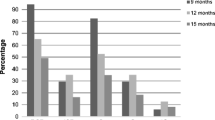Abstract
Infants initially use words and symbolic gestures in markedly similar ways, to name and refer to objects. The goal of these studies is to examine how parental verbal and gestural input shapes infants' expectations about the communicative functions of words and gestures. The studies reported here suggest that infants may initially accept both words and gestures as symbols because parents often produce both verbal labels and gestural routines within the same joint-attention contexts. In two studies, we examined the production of verbal and gestural labels in parental input during joint-attention episodes. In Study 1, parent-infant dyads engaged in a picture-book reading task in which parents introduced their infants to drawings of unfamiliar objects (e.g., accordion). Parents' verbal labeling far outstripped their gestural communication, but the number of gestures produced was non-trivial and was highly predictive of infant gestural production. In Study 2, parent-infant dyads engaged in a free-play session with familiar objects. In this context, parents produced both verbal and gestural symbolic acts frequently with reference to objects. Overall, these studies support an input-driven explanation for why infants acquire both words and gestures as object names, early in development.
Similar content being viewed by others
References
Acredolo, L.P., & Goodwyn, S.W. (1985). Symbolic gesturing in language development: A case study. Human Development, 28, 40–49.
Acredolo, L.P., & Goodwyn, S.W. (1988). Symbolic gesturing in normal infants. Child Development, 59, 450–466.
Acredolo, L.P., Goodwyn, S.W., Horobin, K.D., & Emmons, Y.D. (1999). The signs and sounds of early language development. In C. Tamis-LeMonda & L. Balter (Eds.), Child psychology: A handbook of contemporary issues (pp. 116–139). New York: Garland Press.
Boyatzis, C.J., & Watson, M.W. (1993). Preschool children's symbolic representation of objects through gestures. Child Development, 64, 729–735.
Bruner, J. (1966). On cognitive growth. In J. Bruner, R.R. Olver, & P.M. Greenfield (Eds.), Studies in cognitive growth (pp. 1–29). New York: Wiley.
Fenson, L., Dale, P.S., Reznick, J.S., Bates, E., Thal, D.J., & Pethick, S.J. (1994). Variability in early communicative development. Monographs of the Society for Research in Child Development, 59 (No. 5, Serial No. 242).
Gelman, S.A., Coley, J.C., Rosengren, K.S., Hartman, E., & Pappas, A. (1998). Beyond labeling: The role of maternal input in the acquisition of richly structured categories. Monographs of the Society for Research in Child Development, 63 (No. 1, Serial No. 253).
Goodwyn, S.W., & Acredolo, L.P. (1993). Symbolic gesture versus word: Is there a modality advantage for the onset of symbol use? Child Development, 64, 688–701.
Goodwyn S.W., & Acredolo, L.P. (1998). Encouraging symbolic gestures: A new perspective on the relationship between gesture and speech. In J. Iverson & S. Goldin-Meadow (Eds.), The balance between gesture and speech in childhood (pp. 61–73). San Francisco, CA: Jossey-Bass.
Hodapp, R.M., Goldfield, E.C., & Boyatzis, C.J. (1984). The use and effectiveness of maternal scaffolding in mother-infant games. Child Development, 55, 772–781.
Iverson, J.M., Capirci, O., & Caselli, M.C. (1994). From communication to language in two modalities. Cognitive Development, 9, 23–43.
Iverson, J.M., Capirci, O., Longobardi, E., & Caselli, M.C. (1999). Gesturing in mother-child interactions. Cognitive Development, 14, 57–75.
Jackowitz, E.R., & Watson, M.W. (1980). Development of object transformations in early pretend play. Developmental Psychology, 16, 543–549.
McNeill, D. (1992). Hand and mind: What gestures reveal about thought. Chicago: University of Chicago Press.
Namy, L.L. (in press). What's in a name when it isn't a word? 17-month-olds' mapping of nonverbal symbols to object categories. Infancy.
Namy, L.L., & Waxman, S.R. (1998a). Words and gestures: Infants' interpretations of different forms of symbolic reference. Child Development, 69, 295–308.
Namy, L.L., & Waxman, S.R. (1998b). Words and gestures: The role of naming phrases in infants' mapping of novel symbols to object categories. In A. Greenhill, M. Hughes, H. Littlefield, & H. Walsh (Eds.), Proceedings of the 22nd Annual Boston University Conference on Language Development, 2 (pp. 546–556). Somerville, MA: Cascadilla Press.
Newport, E.L., & Meier, R.P. (1985). The acquisition of American Sign Language. In D. Slobin (Ed.), The cross-linguistic study of language acquisition, Vol. 1: The data (pp. 881–938). Hillsdale, NJ: Lawrence Erlbaum Associates.
O'Reilly, A.W. (1995). Using representations: Comprehension and production of actions with imagined objects. Child Development, 66, 999–1010.
Orlansky, M.D., & Bonvillian, J.D. (1988). Early sign language acquisition. In M.D. Smith & J.L. Locke (Eds.) The emergent lexicon: The child's development of a linguistic vocabulary (pp. 263–292). San Diego, CA: Academic Press, Inc.
Overton, W.F., & Jackson, J.P. (1973). The representation of imagined objects in action sequences: A developmental study. Child Development, 44, 309–314.
Siegel, S., & Castellan, N.J., Jr. (1988). Nonparametric statistics for the behavioral sciences, 2nd edition. Boston, MA: McGraw-Hill, Inc.
Ungerer, J.A., Zelazo, P.R., Kearsley, R.B., & O'Leary, K. (1981). Developmental changes in the representation of objects in symbolic play from 18 to 34 months of age. Child Development, 52, 186–195.
Vygotsky, L.S. (1962). Thought and language. New York: Wiley.
Waxman, S.R., & Hall, D.G. (1993). The development of a linkage between count nouns and object categories: Evidence from 15-to 21-month-old infants. Child Development, 64, 1224–1241.
Waxman, S.R., & Markow, D.B. (1995). Words as invitations to form categories: Evidence from 12-to 13-month-old infants. Cognitive Psychology, 29, 257–302.
Woodward, A.L., Markman, E.M., & Fitzsimmons, C.M. (1994). Rapid word learning in 13-and 18-month-olds. Developmental Psychology, 30, 553–566.
Author information
Authors and Affiliations
Rights and permissions
About this article
Cite this article
Namy, L.L., Acredolo, L. & Goodwyn, S. Verbal Labels and Gestural Routines in Parental Communication with Young Children. Journal of Nonverbal Behavior 24, 63–79 (2000). https://doi.org/10.1023/A:1006601812056
Issue Date:
DOI: https://doi.org/10.1023/A:1006601812056




